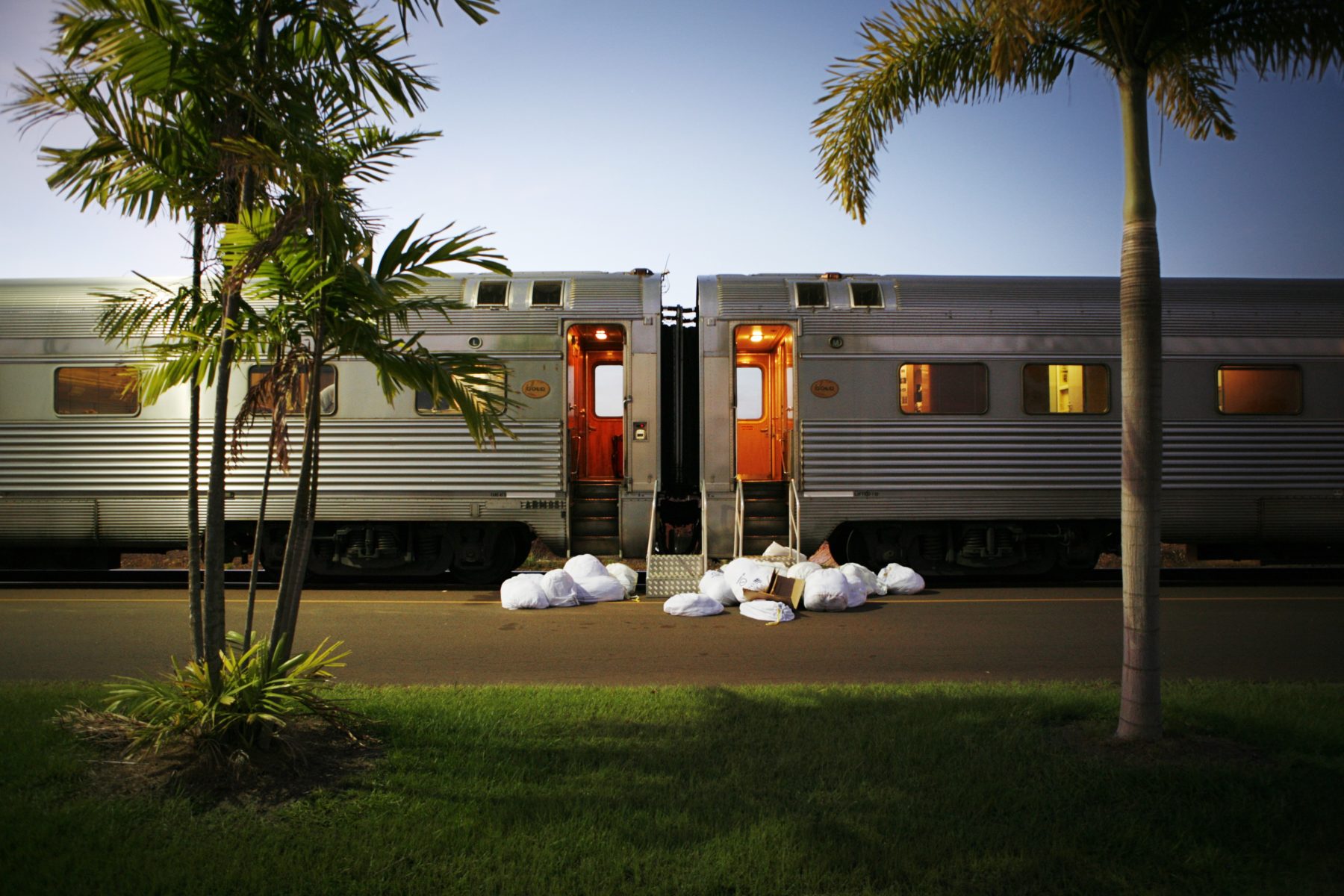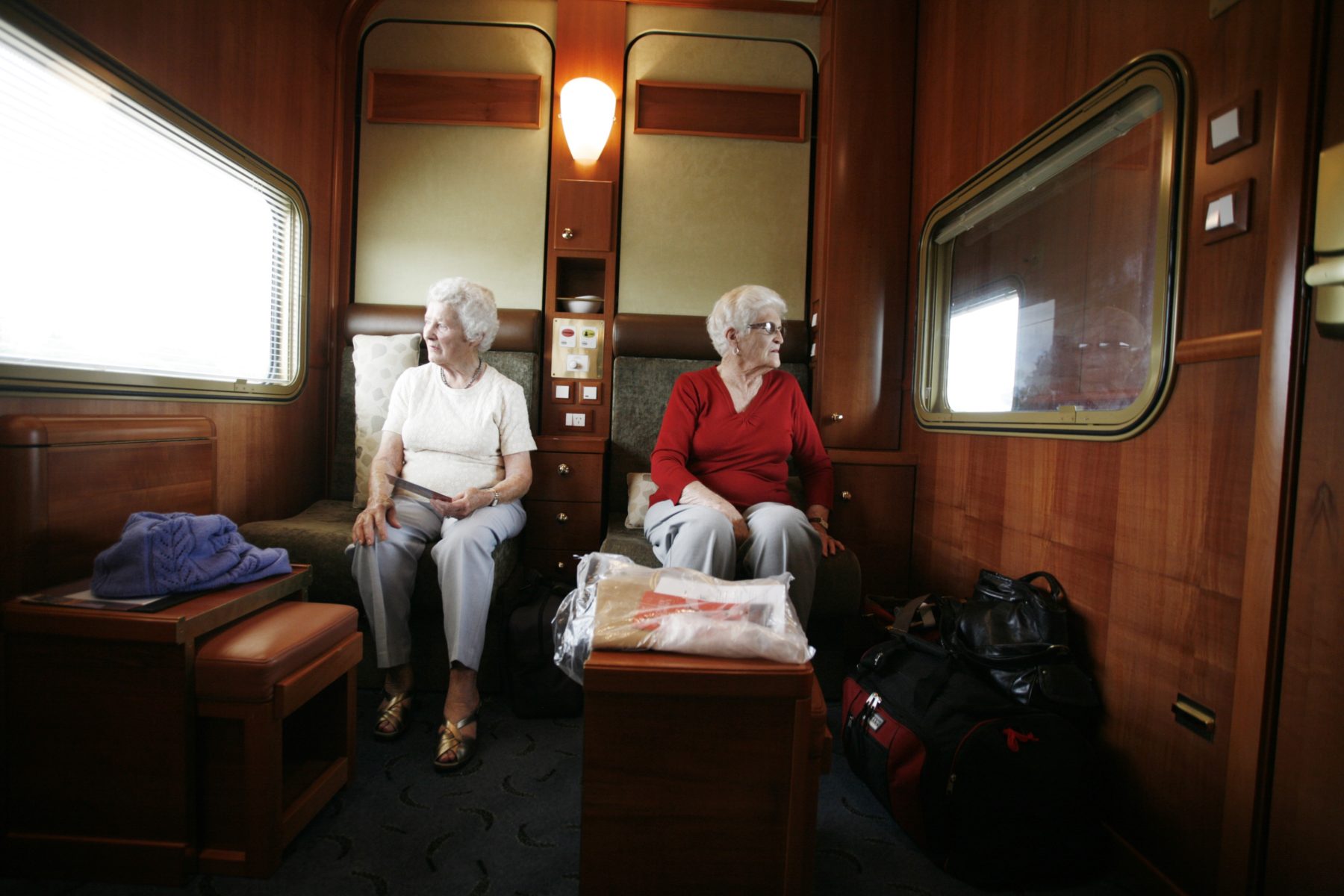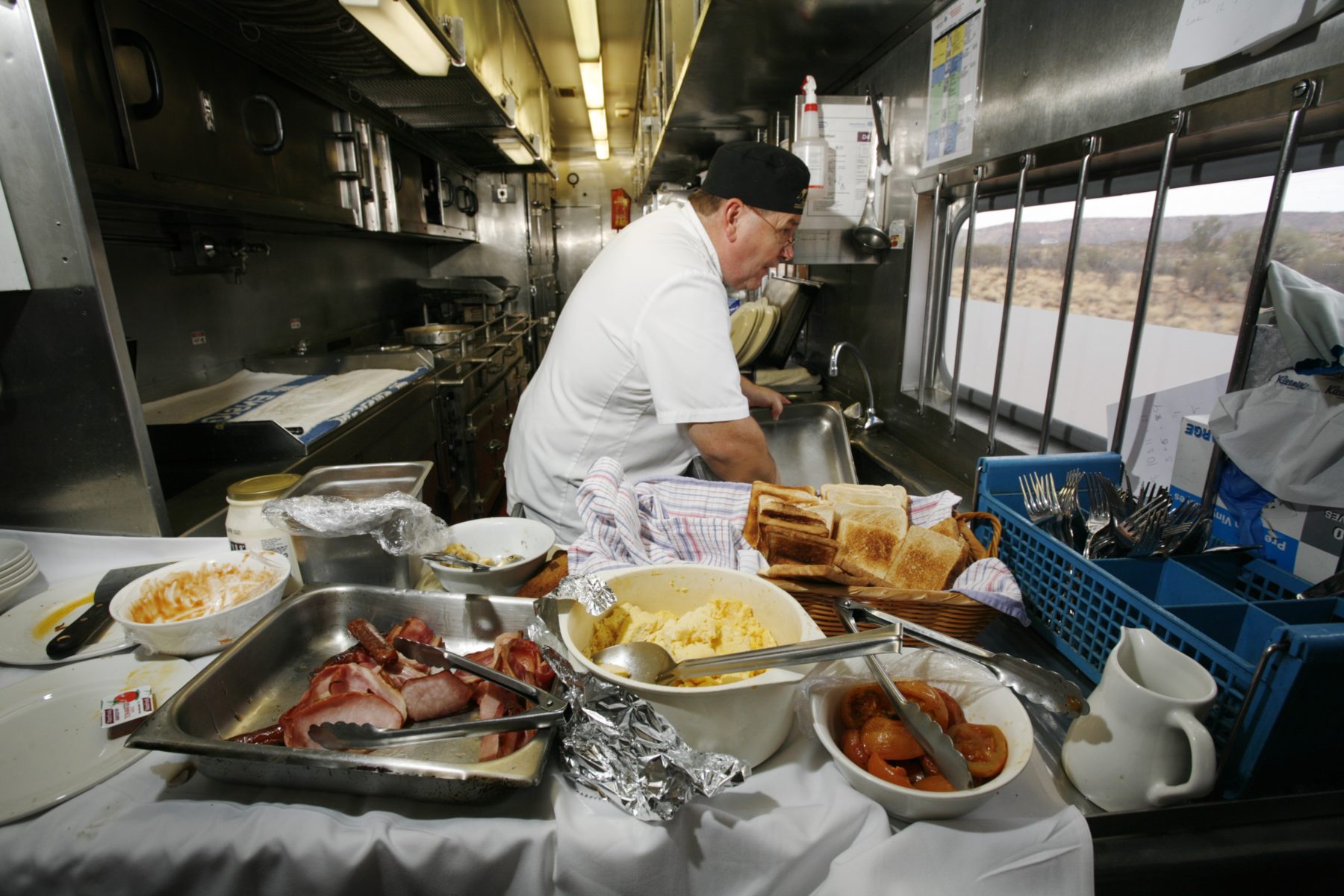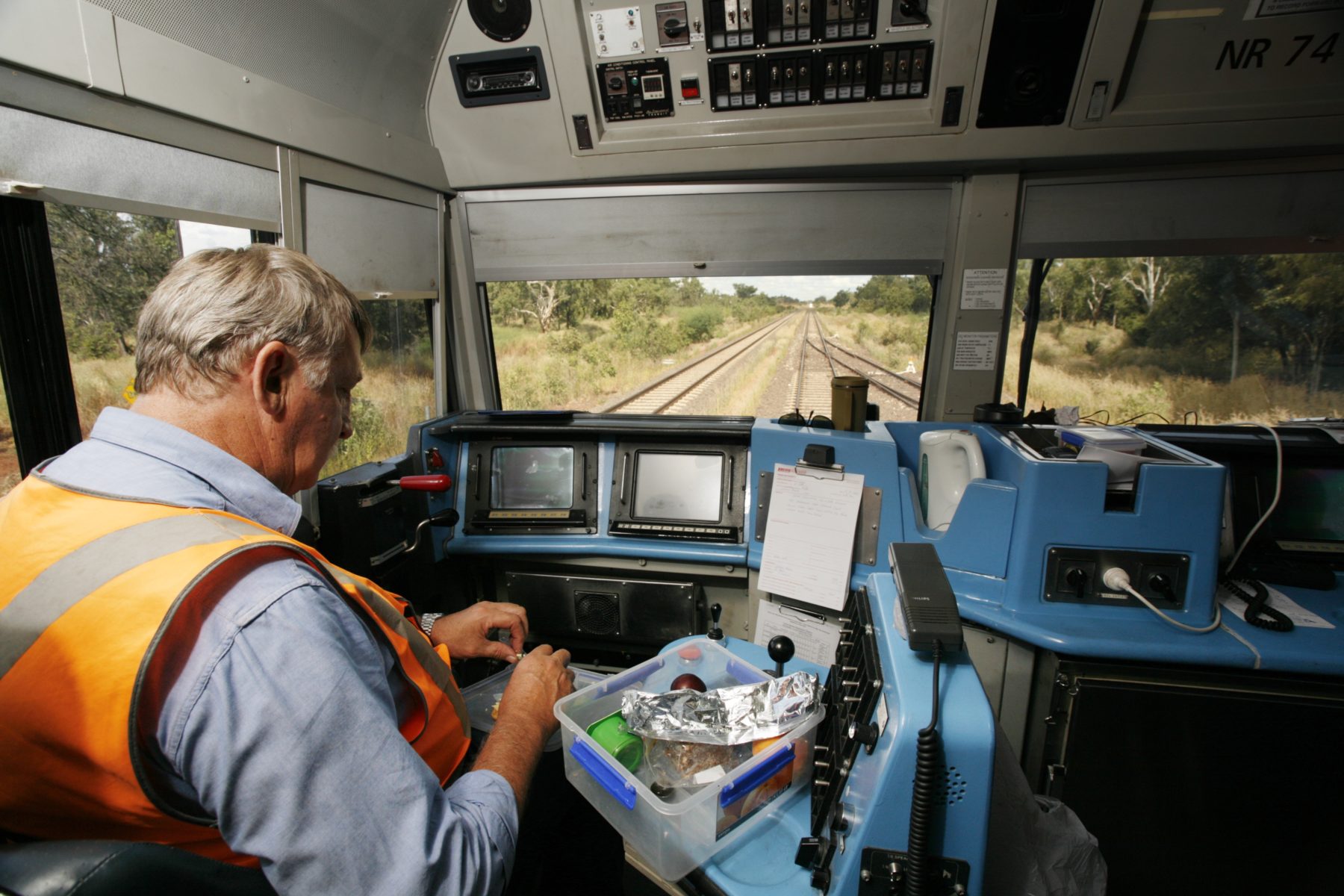The Ghan: Australia’s red centre rail journey

It could be any night in almost any town, but there’s a difference: we’re on the Ghan, speeding across the continent.
The sun has just set, and the local watering hole is bustling. Bartender Sonja Lemondine is trading jokes with a group celebrating an anniversary; lounging nearby a couple of blokes cradling cold beers are swapping tall tales and tips of the plumbing trade. A mother and daughter sit across from each other with glasses of wine; a kid sips lemonade and with her coloured pencils draws a picture of a train. Four friends laugh raucously over the card game “aces and trumps”. “She’s killing us,” exclaims one to me. From the distance come the sounds of the restaurant preparing for the mealtime rush, and waiters pick up the pace as people dressed for dinner arrive for an evening drink. It could be any night, in almost any town in the country, but there’s one big difference: we’re on the Ghan, speeding across the continent on one of the world’s great train journeys.
The Ghan slides like a drop of mercury down the map of Australia, running 2979km between Darwin and
Adelaide in a nation-slicing 54-hour trip. The train’s residents – its crew – start from Adelaide, heading for Darwin and a quick sleepover, returning six days later for four days off. “There’s a rhythm,” says chef James Rosenthal. “It’s full-on work when you’re on board. But when you’re off, you’re off.”
I’ve only been aboard a few hours but I’ve already learnt that here, time takes on a new flexibility.
“Train time runs on food…when dinner starts, when lunch starts,” James tells me. “If anything goes wrong, it’s always food that comes to the rescue,” adds chef John Cousins. There are scheduled stops where passengers disembark in Katherine and Alice Springs – for the crew, these arrival and departure times are referred to in pre- and post-lunch terms. The passengers are on a long-anticipated trip aboard a famous train on which they’ll cross Australia’s arid red heart, but for the staff it’s another day in Ghantown, with a new set of guests, coming to visit their close-knit community.

IN A PLACE where specific skills seem to matter the most – chef, locomotive driver – no-one is as versatile as Ghantown’s Mr Fix-it, Wayne Lehmann. He’s a regular fixture on the “main street”, his lanky figure leaning back against the cabin walls to let lurching passengers pass as he lopes from one end of the train to the other, carrying an intriguing array of tools and gadgets. Wayne’s primary job is the care and guardianship of the two generators in the power van, directly behind the locomotives, that run everything from the kitchens and air conditioning to the hot water and bedside lamps. He’s an electrician by trade, but “you do everything. You’ve got to fix TVs, DVDs, microwaves, air-conditioning, PA systems, brakes”.
When something goes wrong, it’s always a different thing, and in a different place. Someone brought a pedometer on one trip and Wayne used it to measure how far he walked. It was on a 16-carriage train, and not too busy, he says, yet he covered 18 km in a day.

AFTER YOU’VE BEEN aboard the Ghan awhile you relax into the train’s movement and the carriages become your universe. It starts to feel as if the train is the stationary object, and it’s the landscape framed by the windows that’s on the move. The sun goes down on the tropical northern scenery, but by sunrise the next morning, we’re part of a new set of colours and shapes, as the light starts to slide across scrub and sand dune.
Most crew members are due on shift 5–6am, but the train feels deserted, with all the cabins tightly shut. The absence of chatter brings the realisation of how peaceful the train is. “It’s really quiet,” says Ian Kelleher, the night manager. “When you’re out there, when you’re shunting the train, you just don’t hear anything. They call it the ‘silent death’.”
I’ve discovered Ian in one of the kitchens, pouring himself an early morning coffee before the first passengers appear. Like many who work on the Ghan, trains run in Ian’s blood. His father worked on the Ghan, and although Ian has worked in hospitality across Australia, he was drawn back to life on the trains.
He and I share a quiet conversation about his family as crew arrive to set up for the day. They’re busy with their tasks, while swapping stories.
“On my birth certificate my father’s occupation is ‘silver boy’,” Ian tells me, smiling. “He started off cleaning the cutlery.” Hospitality attendant Jess Valentign adds that there used to be “a person in each carriage just to shine the shoes”.
Once breakfast is over for the guests (there are two sittings for each meal) it’s time for the crew to grab some food or, for Ian, a snack before bed. Jess is finishing her morning meal with a cup of sweet coffee – and, for good measure, a teaspoon of honey as a chaser. The early starts are taking their toll, and each has their own method for dealing with it. “Even if you get an hour break, everyone sleeps for 45 minutes. Seven minutes up [to the crew car], seven minutes back…I’ve timed it,” Jess says.
It’s the last full day aboard for the crew, and in the Ghan’s six-day working week, today is known as the “day five monster”, but everyone’s relaxed.
“There’ve been a few conflicts,” James says. “When you’re working so close to people there’s always going to be. But you get to learn to live with the fact that it’s not like you can do your Charlie and storm off – because you’re on the train.”

“TO WORK ON THE TRAINS you’ve got to have a sense of humour,” says John Brinkley, the train manager. “[Staff] have got to know when they can muck around with the guests and when they can’t. They have to know how to speak to people, so they all need experience in hospitality, retail or
customer service.”
John is another character perpetually on the move. At 7.30am, while most of us are considering our cereal options, John can be found striding the length of the train, swinging his briefcase. “I’m the doctor, policeman, mayor,” he tells me good-naturedly, and like all mayors, his work veers between administration, staffing, problem-solving – and a fair number of handshakes.
Even as we talk in the bar carriage, John has an ear cocked for any questions or concerns from the guests around us, breaking off to offer schedule information or tourism trivia. He’s sympathetic to the plight of a woman who missed her chance to see one of the landmarks, the Iron Man sculpture, which commemorates the one-millionth sleeper laid between Tarcoola and Alice Springs. “I think we’ve got a right turn down here somewhere; we can try and turn around for you,” he teases. The woman laughs, returning to her conversation clearly buoyed by the exchange.
John’s one of the rare exceptions to the train-family rule. He was in the Navy for 22 years before joining the railways. He started as a hospitality manager behind the bar, then was night manager, and is now train manager. “I didn’t start out as a train nut, and I still don’t think I am – not yet, anyway.”

IT IS TIME for the last disembarkation. Along the platform, people step down and stand blinking in the stark, hot Adelaide sunshine, hesitating before leaving train time to step back into reality, and its strangely static structure. For the staff there’s still a little bit more paperwork to do, uniforms to hand in and perhaps a drink at the pub. Then it’s off to get four days sleep before they’re back in Ghantown once again.
Find out more at Journey Beyond.




